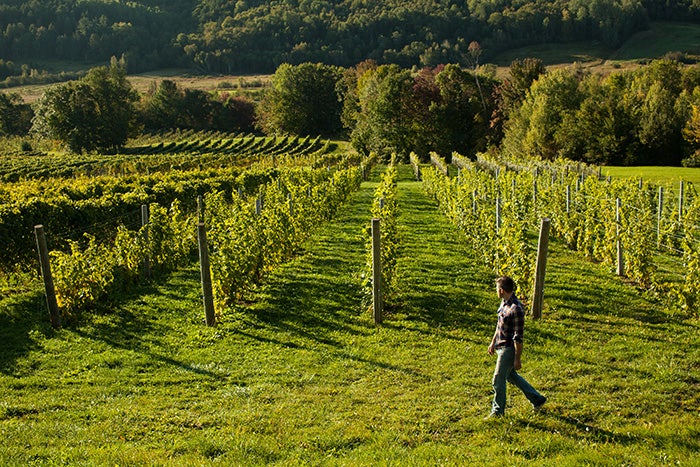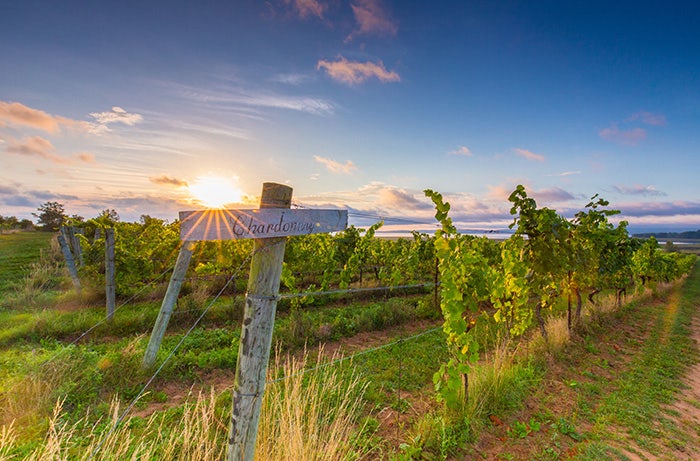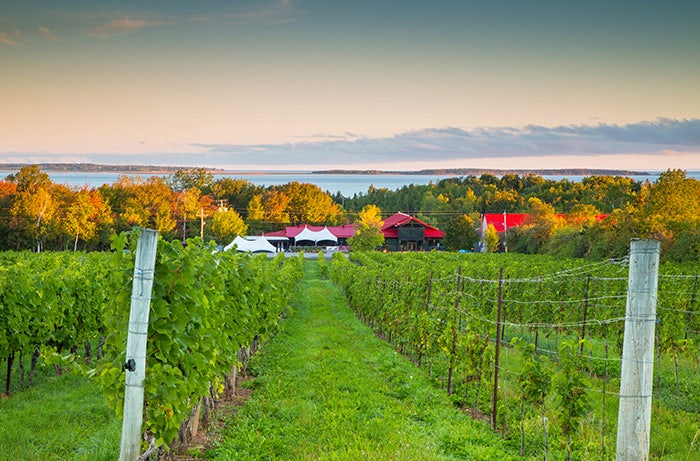Somewhere at the intersection of the adages that “good things come in small packages” and “great wines come from fringe places,” you’ll find Nova Scotia’s wine industry. Canada’s smallest wine region, Nova Scotia hangs off the Atlantic side of North America, an extreme, wind and sea-swept frontier.
Its location doesn’t just provide Nova Scotia the cooling sea breezes and moderating effects key to its cool-climate, acid-bright wines. It was also one of the first stops for explorers from Europe. Vines were planted for wine production as early as the 17th century—one of the first cultivations in North America. With soils carved by the glaciers of the Ice Age and marine-hardy hybrid grapes given preferential treatment, the wines of Nova Scotia are as singularly unique as they come.
It’s also one of the most challenging areas in the world for vines to live. Careful site selection and dedicated viticulture is required to survive the cold, snowy winters. With temperatures that dip to well-below zero, vines need to be dormant and protected to survive. In good winters, there’s enough snow to igloo and protect the vines, with vulnerable younger specimens and grafts sometimes requiring earth mounding.

The province produces fewer than 500,000 cases annually—a drop in the bucket compared to the 21 million cases produced across the country each year. Commercial winemaking has really only been established in the region over the last 25 years. Today, there are more than 70 growers, approximately 20 wineries and 800 acres under vine in seven regions across Nova Scotia.
“You have to embrace the acidity. It just doesn’t drop here.” —Simon Rafuse, Blomidon Estate Winery
Annapolis Valley and Gaspereau Valley are the main wine-producing regions, two east-west valleys that unfold into the Bay of Fundy, which features the highest tides in the world. The daily tidal shift (up to 53.5 feet) transform the valleys into two corridors of moderation. It makes for cooling summer breezes and a large unfrozen body of water in the winter, which allows grapes to thrive.
Nearly a quarter of Nova Scotia wineries produce sparkling wines to take advantage of the region’s hyper-extended growing season.

Jean-Benoit Deslauriers, winemaker for Canada’s most lauded sparkling wine house, Benjamin Bridge, says that the phenolic ripeness found in Sonoma during August achieves those same levels in Nova Scotia during November. That gives months more maturity in the grapes, and it also maintains a laser beam of acidity.
“Greatness in wine is often found when the potential for optimal ripeness is achieved at the 11th hour,” says Deslauriers. “What better illustration of that principle than growing in Nova Scotia?”
“You have to embrace the acidity,” says Simon Rafuse, winemaker at Blomidon Estate Winery. “It just doesn’t drop here.”
Benjamin Bridge has put a lot of focus into traditional Champagne grapes, Chardonnay, Pinot Noir and Pinot Meunier for its traditional method fizz. Like other Nova Scotian wineries, however, it also produces wines from several winter-hardy hybrid grapes.
Aromatic white grapes, both hybrid and vinifera, are used for wines branded with the Tidal Bay appellation. Grapes commonly found in these bright, crisp, floral whites are l’Acadie Blanc, Vidal, Geisenheim, Petite Milo, Ortega, Seyval Blanc and Pinot Gris.
Tidal Bay covers all of Nova Scotia, and the grapes must be approved varieties, 100% Nova Scotia grown and contain no more than 11% alcohol. A tasting panel evaluates the wines to ensure they demonstrate the distinctive Nova Scotian taste profile: lively fresh green fruit, dynamic acidity and characteristic minerality.

Craig Pinhey, co-author of The Wine Lover’s Guide to Atlantic Canada, sees the future of Nova Scotia wines rising as high as the Bay of Fundy’s tides.
“I think vinifera plantings will increase, and we’ll see more good Riesling, Chardonnay and Pinot Noir as table wines, as well as other lesser-known vinifera,” he says. “As for bubbly, we’ve shown we can make great premium traditional-method [sparkling wines] from both classic vinifera and hybrids, but the question is whether the market can bear it. We can certainly make it if there is a market for it.”
Deslauriers sees no reason not to try.
“It only makes sense that a non-stereotypical microclimate, one that is on the edge, does not translate into a versatile terroir capable of excelling in the pursuit of various styles,” he says. “If a specialized environment equals specialized products, the future of Nova Scotia lies in taking the leap of faith of focusing on the few styles that can be achieved at a high level, like traditional method sparkling and crisp, aromatic whites.”
Last Updated: May 4, 2023















